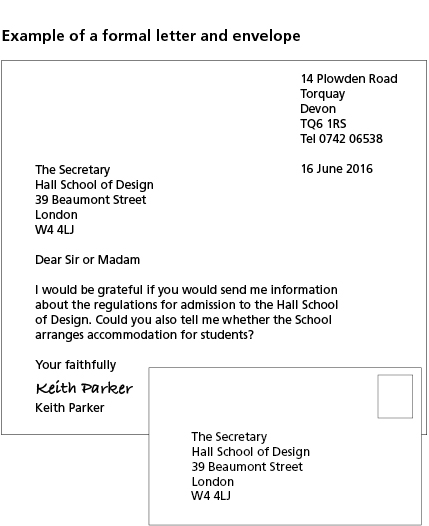Correspondence: letters
Traditionally-constructed letters are now much less common than other forms of correspondence such as emails. However, it is useful to know the normal conventions used in English-speaking cultures – for instance, in letters of application.
-
Put your own postal address at the top on the right or in the centre. Addresses generally follow the rule of ‘smallest first’: house number, then street, then town (and sometimes county) plus postcode. Telephone numbers and electronic addresses come last. Don’t put your name with the address.
-
In formal letters and business letters, put the name and address of the person you are writing to on the left side of the page, starting on the line after your own address.
-
Put the date on the right, on the line after the address of the person you are writing to. A common way to write the date is to put the number of the day, followed by the month and year (e.g. 17 May 2005). For other ways (and differences between British and American customs), (see here).
-
Different styles are common in formal letters on paper which has the address ready-printed at the top of the page. For example, the date may be put on the left, and the address of the person written to may come at the end of the letter or of the first page.
-
Begin the letter (Dear X) on the left. Common ways of addressing people are:
- by first name (informal): Dear Penny
- by title and surname (more formal): Dear Ms Hopkins
- especially to somebody whose name is not known: Dear Sir or Madam, Dear Sir/Madam, Dear Sir, Dear Madam, Dear Sirs (to a company)
-
Some people like to use the first name and surname (Dear Penny Hopkins) when writing to strangers or people that they do not know well.
Do not use a title like Mr together with a first name (notDear Mr James Carter) orDear Mr James. -
After Dear X, put a comma or nothing at all, not an exclamation mark (!). A colon (:) is used in American business letters. Either leave an empty line after Dear X and start again on the left, or start again on the next line, a few spaces from the left. Do the same for each new paragraph. (The first method is now the most common in Britain.)
-
Letters which begin with formulae like Dear Sir(s) or Dear Madam usually finish Yours faithfully in British English. Formal letters which begin with the person’s name (e.g. Dear Ms Hawkins, Dear Peter Lewis) usually finish Yours sincerely. In American English, common endings are Sincerely, Sincerely yours, Yours truly and Cordially. Other less common formulae are (With) best wishes and (With) kind regards.
-
Sign with your first name (informal) or your full name (formal), but without writing any title (Mr/Ms/Dr, etc). Ways of writing one’s full name: Luke Forbes, L Forbes, L J Forbes.
In a formal printed letter, add your full printed name after your handwritten signature. Friendly business letters are often signed with the first name only above the full printed name:
Text version
Yours sincerely
LukeLuke Forbes
-
On the envelope, put the first name before the surname. People usually write a title (Mr, Mrs, etc) before the name. You can write the first name in full (Mrs Angela Brookes), or you can write one or more initials (Mrs A E Brookes).
-
British people now usually write abbreviated titles, initials, addresses, dates, and opening and closing formulae without commas or full stops.
-
American usage is different from British in some ways:
- Dates are written differently (month before day) (see here).
- Americans are often addressed (and sign their names) with the first name in full, followed by the initial of a middle name (Luke J. Parker). This is less usual in Britain.
-
Letter to strangers often being with an explanation of the reason for writing.
- Dear X
- I am writing to ask …
One does not normally begin a letter to a stranger with an enquiry about health. (not
Dear X, How are you getting on?)
For more information about names and titles, (see here).
For more information about the use of commas and full stops, (see here), (see here).
For more information about paragraphing, (see here).

Text version
Example of a formal letter and envelope
14 Plowden Road
Torquay
Devon
TQ6 1RS
Tel 0742 0653816 June 2016
The Secretary
Hall School of Design
39 Beaumont Street
London
W4 4LJDear Sir or Madam
I would be grateful if you would send me information about the regulations for admission to the Hall School of Design. Could you also tell me whether the School arranges accommodation for students?
Your faithfully
Keith ParkerKeith Parker